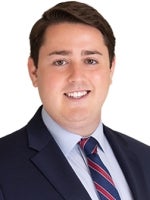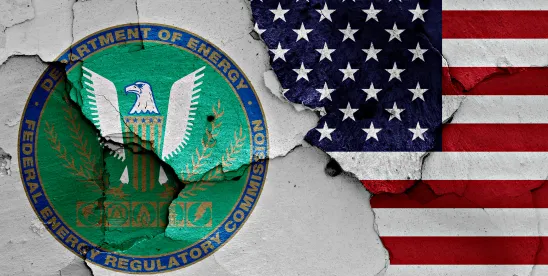During last week’s 20 February 2025 open meeting, the Federal Energy Regulatory Commission (FERC) initiated a show cause proceeding, directing grid operator PJM Interconnection, L.L.C. (PJM) and PJM’s transmission-owning utilities (Transmission Owners) to address the need for tariff changes to govern rates, terms, and service conditions for co-location arrangements.1 The order is likely to have implications nationwide given the growth of data centers and other large loads seeking dedicated energy sources. Co-location, as defined by the order, is a configuration through which end-use customer load is physically connected to the facilities of an existing or planned generator on the interconnection customer’s side of the point of interconnection to the interstate electric grid.2 Data centers and other large loads may use co-location arrangements with various configurations, including grid connections, to arrange for energy supplies.
Chairman Mark Christie’s remarks during the open meeting recognized FERC action to be imperative “because there’s not only billions of dollars of investment waiting for us to act... issues of reliability are directly implicated.”3 He also added, “[t]here’s no question a key utility principle is serve all customers... but [that] has to be done in a way that’s fair and [consistent with] cost causation.”4
The show cause order is directed at PJM following several co-location-related disputes involving entities in PJM. PJM is the largest grid operator in the nation, covering 13 states and the District of Columbia, and is home to the largest concentration of data centers in the nation. PJM is expecting 30 gigawatts of peak load to be added over the next five years.5
While the show cause proceeding focuses on the PJM region, industry is expected to track these developments closely given the broad scope of issues to be addressed. FERC’s decisions here will likely shape the federal regulatory framework governing co-location of data centers and other large loads in those regions or, at a minimum, guide the development of co-location rules adopted by other regional grid operators.
The expansive scope of the show cause proceeding covers issues concerning federal-state jurisdiction, operational reliability of the electric grid, generation resource adequacy, and interconnection study processes, including, e.g.:
- Whether modifications to the tariff, market rules, or interconnection procedures and agreements would be necessary to address the identified issues of jurisdiction, cost causation, the beneficiary pays principle, reliability, and resource adequacy;
- Whether and to what extent different co-location configurations benefit from or rely upon the transmission system, ancillary services, and black start services;
- Whether and to what extent different co-location arrangements impose costs on the transmission system;
- Whether co-located load configurations should be required to take transmission service, such as Network Integration Transmission Service, Point-to-Point Transmission Service, pay for ancillary services even if not taking traditional transmission service, or take a new form of transmission service;
- Whether PJM’s necessary study process for proposed interconnections adequately addresses potential impacts or capabilities of co-location arrangements;
- Whether it would be appropriate to establish an interconnection study process outside of PJM’s interconnection queue process for newly interconnecting co-location arrangements that do not exchange power with the transmission system and do not require network upgrades;
- Whether revisions to PJM’s capacity market rules would be necessary to appropriately reflect the unique physical and operational characteristics of the co-location arrangement; and
- Whether the PJM planning process should be modified to plan for and address resource adequacy impacts of co-location arrangements, particularly whether PJM should consider changes to its load forecasting methods.6
Although FERC has not committed to a date by which it will issue an order in the show cause proceeding, a press release issued 21 February 2025 commits that the agency will act as “quickly... as feasible,”7 and, during the open meeting, the four Commissioners participating in the decision pledged to act quickly. Further, the show cause order itself sets a fast-moving schedule, directing PJM and the Transmission Owners to submit their responses within 30 days, by 24 March 2025, and interested entities to submit comments 30 days later, by 23 April 2025.8 The order also consolidates the show cause proceeding with two other dockets,9 providing a supplement to the record upon which to take action in the show cause proceeding.
On the same day that FERC initiated the show cause proceeding, it also announced that it will convene a two-day Commissioner-led technical conference in Docket No. AD25-7-000 to address resource adequacy issues in regional transmission organization and independent system operator regions, to be held at FERC on 4 June 2025 and 5 June 2025.
The energy regulatory landscape is rapidly changing. The firm is closely monitoring these developments to assist its clients in navigating these evolving laws, regulations, and policies. Members of our Energy Storage and Distributed Resources practice group can assist in better understanding the regulatory issues surrounding the co-location of large loads with generation facilities, as well as the specific regulatory challenges facing data centers’ access to reliable electricity supplies.
Footnotes
1 PJM Interconnection, L.L.C., et al., 190 FERC ¶ 61,115 (2025) (Show Cause Order).
2 Id. at P 3.
3 Chairman Mark Christie, Comments at FERC’s February 2025 Open Meeting (Feb. 20, 2025) (Chairman Christie Comments) (official transcript forthcoming).
4 Id.
5 Commissioner David Rosner, Comments at FERC’s February 2025 Open Meeting (Feb. 20, 2025); see also Chairman Christie Comments (“We all know that the expansion of data centers, especially AI-driven data centers, is having a tremendous impact on load forecasts. We’re seeing load forecasts that as a state regulator for a long time I never thought were possible. We are seeing load forecasts in the double digits, and we have to meet those load forecasts and we have to meet it with generation.”).
6 See Show Cause Order at P 88.
7 FERC Chairman Issues Statement on Review of Issues Associated with the Co-Location of Large Loads at Generating Facilities, FERC (Feb. 21, 2025), https://www.ferc.gov/news-events/news/ferc-chairman-issues-statement-review-issues-associated-co-location-large-loads.
8 Show Cause Order at PP 2, 87.
9 Constellation Energy Generation, LLC, Complaint Requesting Fast Track Processing of Constellation Energy Generation, LLC, Docket No. EL25-20-000 (filed Nov. 22, 2024); Large Loads Co-Located at Generating Facilities, Notice of Commissioner-Led Technical Conference, Docket No. AD24-11-000 (issued Aug. 2, 2024); see also FERC to Hold Commissioner-Led Technical Conference to Discuss Co-location of Large-Load Customers with Generating Facilities, K&L GATES HUB (Aug. 7, 2024), https://natlawreview.com/article/ferc-hold-commissioner-led-technical-conference-discuss-co-location-large-load.






 />i
/>i
